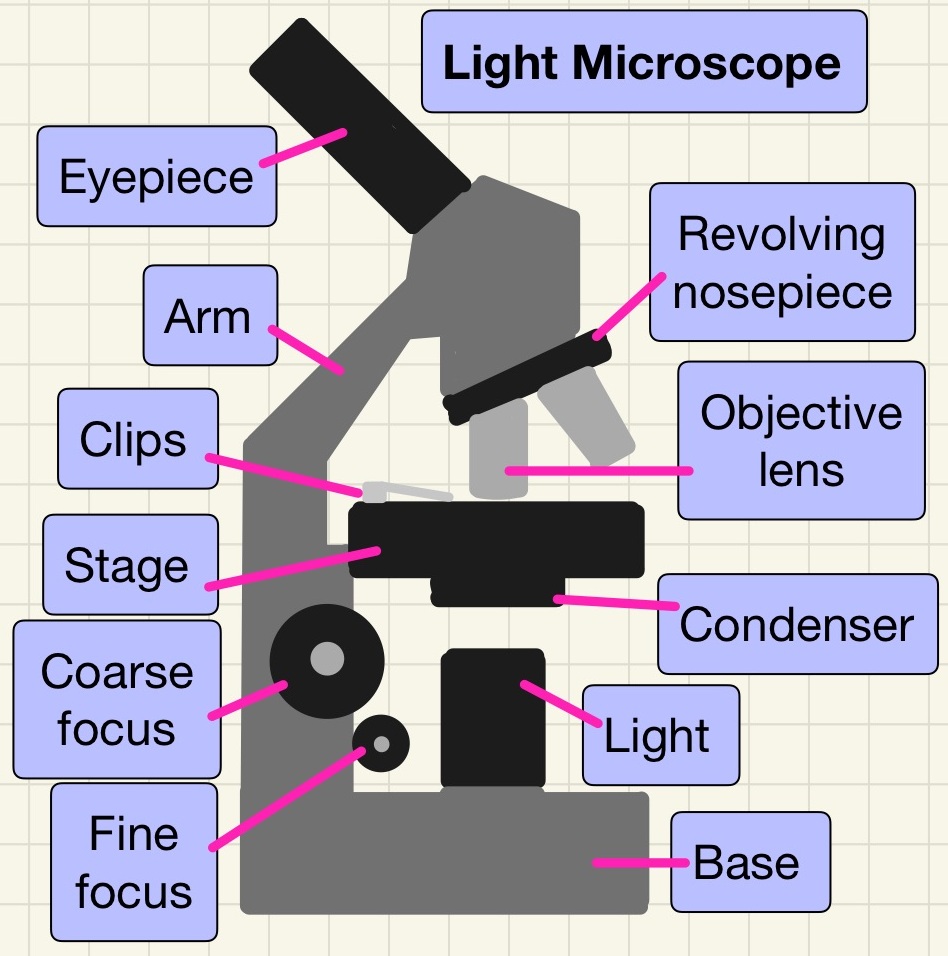Cell Biology
What we are learning:
Animal & plant cells:

There are two main types of cells and they are the animal and the plant cells. They contain organelles which have specific functions. Some organelles are specific to one type of cell and others car common in both. You need to know them, what they do and where you find them:
•Cell membrane: controls substances entering or leaving a cell (both).
•Cytoplasm: fluid where chemical reactions take place (both).
•Ribosomes: where proteins are synthesized (both).
•Nucleus: contains the genetic materials (both).
•Mitochondria: releases energy through respiration (both).
•Cell wall: tough layer of cellulose for structure (plant cells).
•Permanent vacuole: filled with sap, gives the cell rigid shape (plant cells).
•Chloroplasts: contain chlorophyll, where photosynthesis takes place (plant cells).
Animals have skeletons to give them strength, structure and shape. Plants rely on the combination of the cell walls and permanent vacuoles to allow them to stand upright.
Differentiation & specialisation:

Not all of the cells in an organism are the same, in fact, they have specific jobs and are specialised for their jobs. Very early in an animal's development, the cells will differentiate into a specific type such as:
• Sperm cells,
• Cone cells,
• Muscle cells,
• Nerve cells
Plants also have specialised cells but they can differentiate at any time. Examples include:
• Root hair cells,
• Xylem cells.
Stem cells:

In the earliest parts of embryo development, there are stem cells which are undifferentiated cells which can become any type of cell as the embryo develops. As well as for the growth of a baby, these cells can be used to replace damaged cells in children and adults. Stem cells can also be harvested from bone marrow. Although in its early stages, there is promising research showing that these cells can be used to cure diabetes, paralysis, blindness and neurological conditions.
You need to be aware of the ethical debate about using embryonic stem cells. Is it right to create a new embryo and collect its stem cells to help another child and not allow this embryo grow?
Eukaryotes and prokaryotes:

Plant cells and animal cells are called eukaryotes. You are a eukaryote...that's how I remember it anyway. These cells all have a cell membrane, cytoplasm and a nucleus.
Bacterial cells look similar in many respects such as having cytoplasm and a cell membrane, however, they are smaller and they have a cell wall and no nucleus. Their genetic material is in a plasmid. A plasmid is either a single loop of DNA or a several small rings of DNA. These types of cells are called prokaryotes.
Microscopy:

In school, you need to be familiar with using a light microscope. You should complete the required practical. Magnification can be worked out by adding the magnification of the two lenses on the microscope. If there is a x10 lens and then the x4 lens, the overall magnification is x40. We can then use this formula to work out the real size of cells under the microscope:
Real size = image size/magnification
Electron microscopes have a much higher resolution and can be used to see cells and organelles in much more detail.
Chromosomes & mitosis:

It is important to remember the relationships between genes, chromosomes and DNA as it is easy to forget. Chromosomes are made up of DNA and each chromosome has lots of genes in its structure. The chromosomes are found in the nucleus of the cells.
When a cell reproduces, it makes an identical copy of itself. This is called mitosis. At the start of the cycle, the genetic material (DNA/chromosomes) make an exact copy of themselves so that there are 2 sets in the nucleus. The cell swells and becomes larger then splits into identical halves. Each half has a nucleus with identical genetic information. These 2 cells are completely identical or clones.
Difusion, osmosis & active transport:

Diffusion:
Diffusion is the movement of substances in and out of cells through the cell membrane. Oxygen & glucose diffuse in, carbon dioxide & urea diffuse out. Other substances are also involved in lesser amounts. Diffusion is simply the movement of particles from a high concentration to a lower concentration. In a classroom, if a student tries to secretly eat their lunch without being caught, if they have a tuna sandwich, the smell spreads throughout the classroom via diffusion. Single cell organisms have organelles to help with this as they do not have the circulatory system that we have to deliver and take away substances to the cell membrane.
Osmosis:
This is the movement of water across the membrane from an area of low concentration (dilute) to an area of high concentration. The membrane is referred to as semi-permeable. You will get to test this out in a the required practical.
Active transport:
If we want to move substances such as nitrates from soil for plants or glucose from our intestines in animals, we need them to go from an area of low concentration (the soil or inside the intestines) to an area of higher concentration (inside root hair cells or in our blood). This move against the concentration gradient needs energy from respiration to make this happen.
Key words/terms for this topic
Active transport Adult stem cell Binary fission Cell cycle Cell membrane Cell wall Chloroplast Chromosome Clone Concentration Cytoplasm Daughter cells Differentiate Diffusion Diffusion Dilute DNA Embryonic Embryonic stem cell Eukaryote/eukaryotic Flagella Gene Gill filaments Gradient Magnification Meristem Mitochondria Mitosis Nucleus Osmosis Osmosis Partially permeable membrane Passive process Permanent vacuole Plasmid Prokaryote/prokaryotic Resolution Resolution Ribosome Root hair cell Stomata Surface Area to Volume Ratio Therapeutic cloning Turgid
Curriculum Health Check:
Q: What happens in the mitochondria?
A: Protein synthesis
B: Respiration
C: Photosynthesis
D: DNA replication
What you need to know
Eukaryotic cells - Plant and animal cells, what they contain and the functions of all of the organelles including the location of chromosomes (normally found in pairs) and DNA in the nucleus.

Prokaryotic cells - Bacterial cells, their make-up and how they are different from above.

Specialised cells and what makes them special for their role, learn examples such as sperm, nerve, muscle, root hair, xylem and phloem cells.

Stem cells and differentiation, including the meristem tissues of plants. Look into the possibility of stem cells being used to treat diabetes and paralysis. Look into the financial, moral and ethical thoughts of stem cell use as well as the risks of viral transfer.

Mitosis and all of the processes of the cell cycle

You need to understand osmosis, diffusion and active transport. Make sure that you are happy with the maths involved in calculating percentage mass gain or change.

Using a microscope and calculating magnification.

This page was updated on: 13th April 2024


